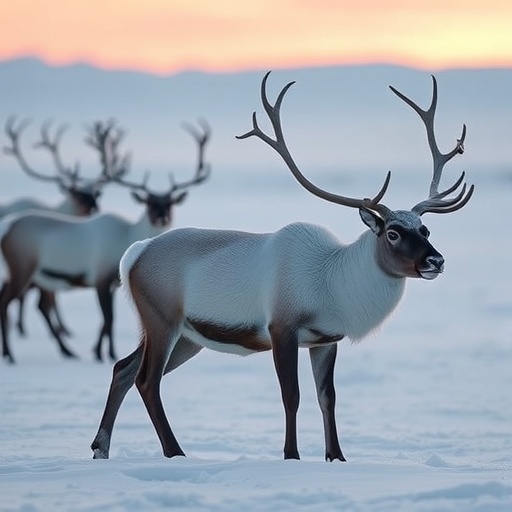In an era marked by unprecedented climatic upheavals, recent research spearheaded by an international team of scientists from the University of Adelaide and the University of Copenhagen reveals that reindeer—iconic Arctic herbivores also known as caribou in North America—are facing declines in population and habitat distribution that eclipse those experienced at any time in the last 21,000 years. These revelations pose a significant challenge to conservationists and policymakers alike, as reindeer are integral to Arctic ecosystem stability and the subsistence of numerous Indigenous communities.
Reindeer have long been regarded as emblematic survivors of the Ice Age, exhibiting exceptional adaptations that enable them to thrive in Arctic environments characterized by harsh winters, short summers, and a fragile tundra biome. Their physiological and behavioral traits, honed over millennia, allow them to regulate plant communities and maintain biodiversity, underpinning ecosystem services that extend far beyond their immediate habitat. However, the modern era’s accelerating climate warming threatens to disrupt this delicate balance, imposing stressors unlike any encountered during historical warming episodes.
The research, recently published in the esteemed journal Science Advances, utilized a multifaceted approach combining fossil records, ancient DNA analyses, and cutting-edge computational climate models to reconstruct the fluctuations in reindeer populations over the past 21,000 years. This timeline encompasses the transition from the Last Glacial Maximum through various interglacial periods, offering a comprehensive perspective on how reindeer populations historically responded to natural climate variability. Remarkably, while past warming events triggered notable population declines, projections for the 21st century suggest losses of an unprecedented scale unless immediate interventions are implemented.
Lead investigator Dr. Elisabetta Canteri explains that the methodological innovation of integrating ancient genetic data with high-resolution climate proxies enabled the team to resolve population trends with exceptional temporal precision. The analysis unveiled that historical climate warming, albeit substantial, was often counterbalanced by adaptive migration and habitat shifts. Contrastingly, current and projected warming trends, amplified by anthropogenic greenhouse gas emissions, outpace the adaptive capacity of many reindeer populations, particularly those in North America.
Associate Professor Damien Fordham highlights the vulnerability of North American caribou, where model forecasts indicate potential population reductions of up to 80% by the year 2100 without significant mitigation efforts. This catastrophic decline stems from multiple interrelated factors, including habitat fragmentation, altered vegetation dynamics, and increased frequency of extreme weather events, all compounded by human activities such as industrial development. The confluence of these threats endangers not only the species but also the broader Arctic ecological functions dependent on reindeer grazing patterns.
The ecological ramifications of such declines are profound. Reindeer act as keystone species within the tundra biome, exerting top-down control on vegetation composition and productivity. By selectively feeding on certain plants and trampling others, they sustain a mosaic of plant diversity crucial for carbon sequestration and soil stability. The disappearance of reindeer from landscapes could precipitate a loss of this diversity, leading to declines in Arctic soil carbon storage, a feedback mechanism with global climate implications. Professor Eric Post articulates this concern, underscoring that increased soil carbon release would exacerbate atmospheric greenhouse gas concentrations, creating a dangerous positive feedback loop that hastens climate change and further threatens species resilience.
Beyond ecological considerations, the wellbeing of Indigenous Peoples who depend on reindeer for subsistence, cultural identity, and economic livelihoods is inextricably linked to these findings. For thousands of years, robust reindeer populations have supported Arctic communities, shaping their traditions and sustenance practices. The anticipated declines forecast a future where these communities may face increased food insecurity, cultural erosion, and economic hardship. Therefore, safeguarding reindeer is not merely an environmental imperative but also a sociocultural necessity.
This study delivers a compelling call to action. It emphasizes the urgent need for enhanced investment in conservation strategies designed to bolster reindeer resilience in the face of rapid climate change. Such strategies could include habitat protection, restoration initiatives, hunting regulation, and sustainable wildlife management to offset the pressures induced by industrial expansion and climate variability. The researchers advocate for coordinated international efforts, particularly focusing on North American populations at greatest risk.
Technologically, the research exemplifies a paradigm shift in how scientists approach historical ecology and conservation forecasts. The integration of paleogenomics and advanced modeling tools enables unprecedented accuracy in predicting species responses to environmental stressors. This research framework sets a precedent for future studies aiming to decipher the complex interplay between climate dynamics and biodiversity, providing a blueprint for proactive ecosystem management amid global change.
Moreover, the study illuminates the broader implications of biodiversity loss under climate change. Reindeer declines are emblematic of a growing pattern where species adapted to cold environments confront existential threats due to warming temperatures and anthropogenic pressures. Understanding these dynamics and their cascading effects on ecosystem processes is vital in informing global climate policies that address both mitigation and adaptation.
In conclusion, the findings from this comprehensive study underscore a stark mismatch between historical resilience and future vulnerability of reindeer populations. The impending losses, if unchecked, threaten to unravel the ecological and cultural fabric of the Arctic. Yet, through informed conservation and decisive climate action, it remains possible to alter this trajectory, preserving these emblematic species and the ecosystems—and people—that depend on them. This research not only expands scientific knowledge but also serves as a clarion call for the stewardship of our planet’s rapidly changing environments.
Subject of Research: Animals
Article Title: Mismatch in reindeer resilience to past and future warming signals ongoing declines
News Publication Date: 13-Aug-2025
Web References: https://doi.org/10.1126/sciadv.adu0175
References: Canteri, E., Fordham, D. A., Post, E., et al. (2025). Mismatch in reindeer resilience to past and future warming signals ongoing declines. Science Advances, [DOI:10.1126/sciadv.adu0175].
Keywords: Reindeer, Caribou, Arctic warming, Climate change, Population decline, Ancient DNA, Paleogenomics, Ecosystem services, Tundra biodiversity, Conservation, Indigenous Peoples, Climate modeling




